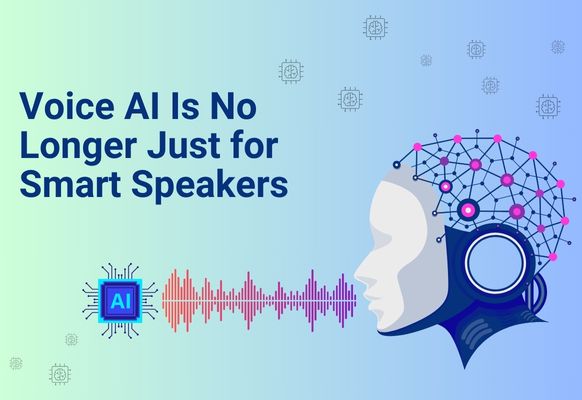How Voice AI Technology Is Changing the Way We Use Devices
Voice AI used to be something thrilling only a few years ago. You would call your smart speaker either Hey Google or Alexa, and it would answer you, play music, or tell the time. It was used in that way by most people.
However, voice AI is presently doing much more. It is not only a household appliance anymore. Voice technology has advanced to apps, cars, websites, customer service, hospitals, and even in offices. It makes people work quicker, more secure, and with less strain.
This blog will examine the rise of voice AI, where voice AI is currently used, what issues it is solving, and what voice AI will bring us in the future.
Table of Contents
- What Is Voice AI
- How Voice AI Is Used Outside the Home
- Where People Use Voice AI in Daily Life
- How Voice AI Makes Life Easier
- What Problems Voice AI Still Has
- What Voice AI Could Do in the Future
What Is Voice AI
Voice AI is a type of software that hears what you say, interprets it, and responds with a useful answer. It operates in two key technologies: speech recognition and natural language processing. This implies that the computer is able to listen and comprehend what is being said and reply with something useful.
Voice AI You have already used voice AI when you have ever used Siri on an iPhone, Google Assistant on Android, or Alexa at home. These voice assistants learn your habits to give better answers over time.
How Voice AI Is Used Outside the Home
Initially, voice AI was only popular in smart speakers. It was used by people to play music, pose queries or switch on and off lights at home. However, it is used in many places.
There are a few reasons for this change. To begin with, technology is improving faster. It is able to comprehend sounds better now. Second, a greater number of people are comfortable talking to machines. Third, it is simpler to implement voice AI on phones, cars, and websites.
But today, voice AI is not a home function. It has become a block of our daily equipments.
Where People Use Voice AI in Daily Life
In Cars and Driving
Voice systems are fitted in most cars today. You can tell your car to make a phone call, adjust the radio, or even give a direction. You do not have to touch anything on the screen or look away. This will make driving safe and comfortable.
In Customer Service
Voice systems are used to answer phones in many companies. You can chat with a smart system, which knows what you ask and can assist you, as opposed to having to wait to talk to somebody in person. This is time-saving for the customer and the business.
In Phones and Apps
Voice search is possible on most phones. You may tell your phone to send a message, launch an app or search for something online. The voice also applies to some shopping and banking applications. This is beginning to form the future of e-commerce, where individuals can shop by talking.
In Healthcare
With voice tools, doctors and nurses can enter patients quickly by taking notes. They talk instead of typing and the system records. Other hospitals use voice AI to verify patient records and schedule visits. This makes healthcare quicker and less error-prone.
In Offices and Workplaces
People also utilize Voice AI at work. It is able to make appointments, place reminders and even make notes on calls. Voice features are also put in smart tools so that some teams can save time. These tools are AI tools 2025 which assist in daily activities such as planning and writing.
How Voice AI Makes Life Easier
Voice AI introduces numerous advantages to daily life.
The first advantage is that it saves time. Speech is quicker than writing. You have the ability to talk about your task and have it done without using your hands. This assists in driving, cooking or even other activities.
The second advantage is improved access. Voice tools are easier for people who have limited sight or movement to use than touchscreens. With the use of their voice alone, they can open applications, read messages or call somebody.
The other advantage is that voice systems are able to memorize what you like. For example, they can play your favorite music, remind you of your schedule, or respond to you in a kind of intimate way.
More users of voice features are using them in homes and offices as technology advances. Voice-first tools are turning out to be a routine.
What Problems Voice AI Still Has
Voice AI is advancing, yet there are certain issues.
Among the major problems is the need to know the accents. Different people talk in different ways, and the system does not always pick them correctly. This might result in erroneous responses.
The other issue is background noise. In case of loud music or talking to people, the voice system can fail to understand your command properly.
There is an issue of privacy, too. Other users are concerned about the eavesdropping of their voice tools. There are individuals who feel awkward to hoard or archive voice data.
In addition, voice AI is not always aware of the complete meaning of what one speaks. It can also request repetition or wrong answers. This is a frustrating fact.
These issues notwithstanding, voice AI is improving on a daily basis. Programmers are struggling to make it more precise and confidential.
What Voice AI Could Do in the Future
Voice technology will continue to expand further in the coming years. It will be even more natural and smarter. Human beings can even communicate freely with their devices rather than issuing brief commands.
More voice AI will pop up in smart homes, schools, hospitals, and shops, too. At home, it is going to collaborate with smart home security systems. You can lock doors, review cameras and manage alarms by simply talking.
Students can learn in schools by using voice tools. Voice systems at offices can assist teams in writing reports, planning projects and handling files with reduced people effort.
Voice will also be used so that businesses assist in helping customers more quickly. It will allow customers to order and request assistance without using a screen.
This future will allow technology to be used by all in an easy way. A normal conversation with the digital world is turning into voice AI.
Conclusion
Smart speakers are no longer the only use of voice AI. It is now present in phones, apps, cars, offices, hospitals, and a lot more.
It makes life more convenient for people, saves time, and offers safety. Although minor problems exist, such as privacy and interpretation of accents, voice tools are advancing quickly.
Very soon, you might never need to execute even a minor touch on your phone or your computer. All you are going to do is talk, and the machine will know what you desire.
Voice AI is a cool thing; it is becoming a natural thing. It is an intelligent lifestyle, career and interaction with the surrounding environment.
